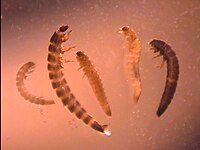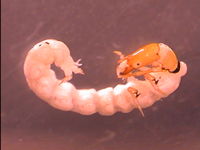Maracuto Creek 105
From WikiEducator
| Stream code: | RGL_MrcutoCrk_105 |
| Basin: | Rio Grande de Loiza |
| State or Province: | Puerto Rico |
| Country: | USA |
| Latitude: | 18.35625 |
| Longitude: | -65.95206 |
| School: | Jose E. Aponte de la Torre |
The following are the most common invertebrates collected from this stream site.
Chironomidae
Midge larvae tend to be the most common macroinvertebrate at our sites. As with other Diptera, there are no true jointed legs. Chironomidae do have a pair of prolegs at each end and preserved individuals tend to curl into a 'C'. Identification past family requires slide-mounted heads. We have seen philopotamid caddisflies misidentified with the chironomids and we suspect that that happens when samples are being sorted from trays. Under a microscope, six prominent legs can be seen on members of the caddisfly family Philopotamidae.
More information on Philopotamidae.
Elmidae
We very commonly find adult and larval riffle beetles. The adults are clearly beetles, but the larvae can be confused with other orders. The forward pointing tooth on the front end of the larvae as described in the key can be a challenge to see, particularly in small individuals. Larvae are characterized by having a single tarsal claw at the end of their legs, which have 4 segments. Adults, on the other hand, have two tarsal claws at the end of each leg. Commonly encountered genera include Dubiraphia, Macroychu, Optioservus, Phanocerus, Promoresia, and Stenelmis.
Images of the adult and larval riffle beetles.
More information on Dubiraphia, Macronychus, Optioservus, Phanocerus, Promoresia, and Stenelmis.
Philopotamidae
Philopotomidae are net-spinning filtering collectors. A casual observer might sort them with Chironomidae, but a close look reveals six jointed legs. The faint white 'T' shaped labrum extending from the front of the head past the mandibles is diagnostic for the family (it is sometimes withdrawn and hard to see).
Image of the faint white 'T' shaped labrum. Common genera include Dolophilodes, Wormaldia, and Chimarra.



